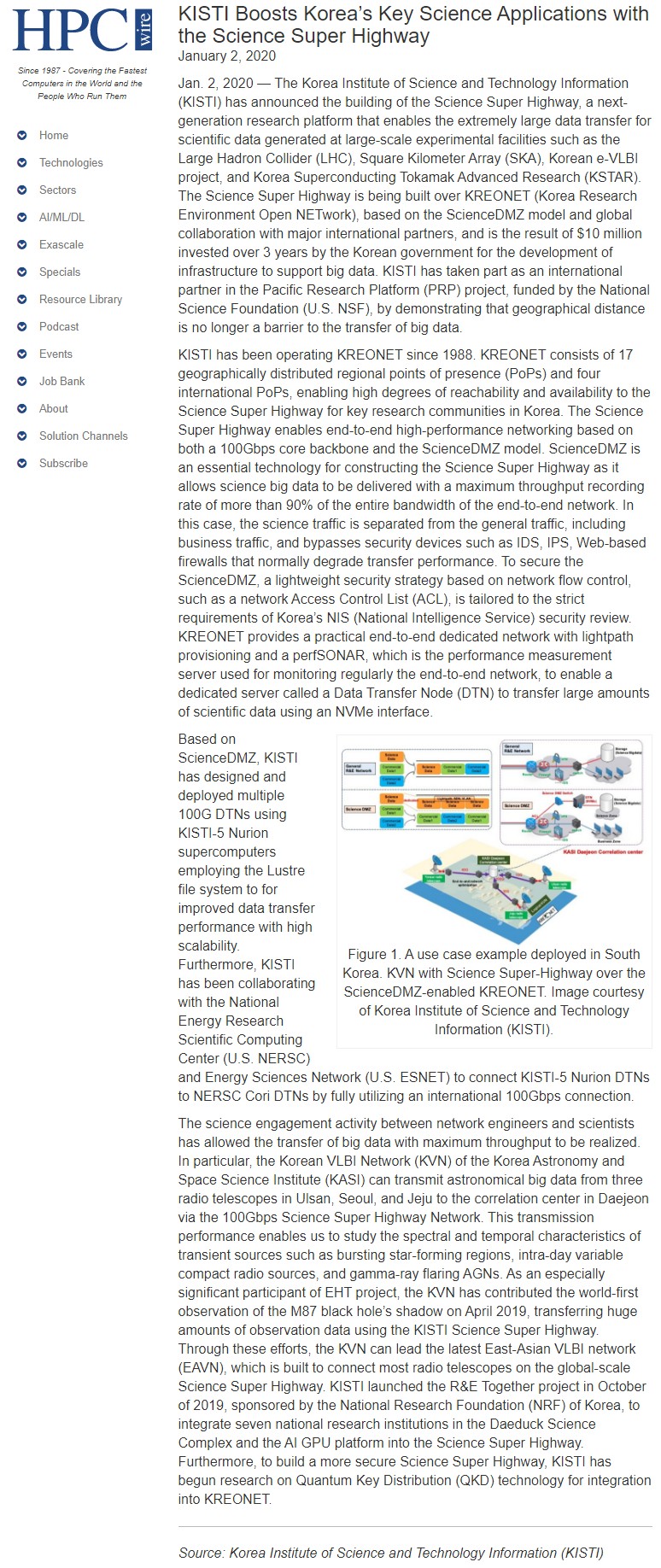국가과학기술연구망(KREONET)의 'ScienceDMZ' 미국 IT 전문지인 HPC WIRE에 게재
손영주 2020-01-08 View. 48,233 https://www.hpcwire.com/off-the-wire/kisti-boosts-koreas-key-science-applications-with-the-science-super-highway/이번 1월 2일, 국가과학기술연구망(KREONET)의 'ScienceDMZ'에 관한 기사가
아래와 같이 미국 IT 전문지인 HPC WIRE에 게재되었습니다.

HPC Wire
- Home
- Technologies
- Sectors
- AI/ML/DL
- Exascale
- Specials
- Resource Library
- Podcast
- Events
- Job Bank
- About
- Solution Channels
- Subscribe
Since 1987 - Covering the Fastest Computers in the World and the People Who Run Them
KISTI Boosts Korea’s Key Science Applications with the Science Super Highway
January 2, 2020
KISTI has been operating KREONET since 1988. KREONET consists of 17 geographically distributed regional points of presence (PoPs) and four international PoPs, enabling high degrees of reachability and availability to the Science Super Highway for key research communities in Korea. The Science Super Highway enables end-to-end high-performance networking based on both a 100Gbps core backbone and the ScienceDMZ model. ScienceDMZ is an essential technology for constructing the Science Super Highway as it allows science big data to be delivered with a maximum throughput recording rate of more than 90% of the entire bandwidth of the end-to-end network. In this case, the science traffic is separated from the general traffic, including business traffic, and bypasses security devices such as IDS, IPS, Web-based firewalls that normally degrade transfer performance. To secure the ScienceDMZ, a lightweight security strategy based on network flow control, such as a network Access Control List (ACL), is tailored to the strict requirements of Korea’s NIS (National Intelligence Service) security review. KREONET provides a practical end-to-end dedicated network with lightpath provisioning and a perfSONAR, which is the performance measurement server used for monitoring regularly the end-to-end network, to enable a dedicated server called a Data Transfer Node (DTN) to transfer large amounts of scientific data using an NVMe interface.
Based on ScienceDMZ, KISTI has designed and deployed multiple 100G DTNs using KISTI-5 Nurion supercomputers employing the Lustre file system to for improved data transfer performance with high scalability. Furthermore, KISTI has been collaborating with the National Energy Research Scientific Computing Center (U.S. NERSC) and Energy Sciences Network (U.S. ESNET) to connect KISTI-5 Nurion DTNs to NERSC Cori DTNs by fully utilizing an international 100Gbps connection.
Figure 1. A use case example deployed in South Korea. KVN with Science Super-Highway over the ScienceDMZ-enabled KREONET. Image courtesy of Korea Institute of Science and Technology Information (KISTI).
The science engagement activity between network engineers and scientists has allowed the transfer of big data with maximum throughput to be realized. In particular, the Korean VLBI Network (KVN) of the Korea Astronomy and Space Science Institute (KASI) can transmit astronomical big data from three radio telescopes in Ulsan, Seoul, and Jeju to the correlation center in Daejeon via the 100Gbps Science Super Highway Network. This transmission performance enables us to study the spectral and temporal characteristics of transient sources such as bursting star-forming regions, intra-day variable compact radio sources, and gamma-ray flaring AGNs. As an especially significant participant of EHT project, the KVN has contributed the world-first observation of the M87 black hole’s shadow on April 2019, transferring huge amounts of observation data using the KISTI Science Super Highway. Through these efforts, the KVN can lead the latest East-Asian VLBI network (EAVN), which is built to connect most radio telescopes on the global-scale Science Super Highway. KISTI launched the R&E Together project in October of 2019, sponsored by the National Research Foundation (NRF) of Korea, to integrate seven national research institutions in the Daeduck Science Complex and the AI GPU platform into the Science Super Highway. Furthermore, to build a more secure Science Super Highway, KISTI has begun research on Quantum Key Distribution (QKD) technology for integration into KREONET.
Source: Korea Institute of Science and Technology Information (KISTI)
한국과학기술정보연구원(이하 KISTI)은 강입자충돌기(LHC), SKA(Square Kilometer Array), 한국형 초장거리전파간섭계 프로젝트(Korean e-VLBI project), KSTAR(차세대 초전도 핵융합 연구장치) 등과 같은 대형실험시설에서 만들어지는 과학 데이터의 대용량 전송을 가능케하는 차세대 연구 플랫폼인 Science Super Highway의 구축을 발표했다.
Science Super Highway는 ScienceDMZ 모델과 주요 글로벌 파트너와의 협업에 기반하여, 한국 국가과학기술연구망인 KREONET을 통해 구축되고 있으며, 이는 빅 데이터 지원 인프라 구축을 위해 한국 정부가 관심을 가지고 투자한 결과이다.
KISTI는 빅 데이터 전송에 있어 지리적 거리는 더 이상 장벽이 될 수 없다며, 미국 국립과학재단(NSF)의 지원을 받는 PRP(Pacific Research Platform) 프로젝트의 글로벌 파트너로 참가하고 있다. (중략)
ScienceDMZ를 바탕으로 KISTI는 고확장성을 겸비한 향상된 데이터 전송 성능을 위해 러스터 파일 형식을 채용한 슈퍼컴퓨터 5호기 누리온을 사용하는 100G급 다용도 DTN(데이터 전송 노드)을 설계 및 운용하고 있다.
더불어, KISTI는 슈퍼컴퓨터 5호기 누리온의 DTN과 미국 에너지부 국립에너지연구과학컴퓨팅센터(NERSC)의 슈퍼컴퓨터 코리(Cori)의 DTN을 연결시키기 위해 100G급 국제망을 가동하여 NERSC 및 미국 에너지과학연구망(ESNET)과 협력하고 있다. (하략)

본 저작물은 “공공누리 제4유형(출처표시, 상업적 이용금지, 변경금지)” 조건에 따라 누구나 이용할 수 있습니다.
- 담당부서
- 담당자박성욱
- 연락처042-869-1610

 Delete Article!
Delete Article!